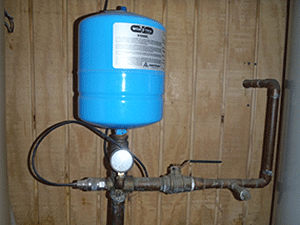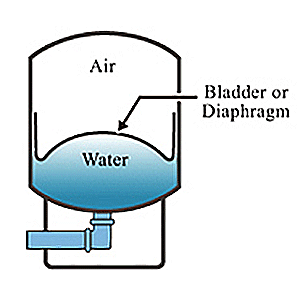You may take the pressure tank in your private water system for granted. But it is a good idea to understand the purpose of the tank and how it works.
The pressure tank in a private water system has three purposes. It stores water and provides water under pressure when the pump is not running. It builds up a reserve supply of water so the pump starts and stops less often, prolonging the life of the pump. In addition, it provides a reserve supply of water for use during times of high demand.
Operation of a pressure tank is based on physical properties. Water cannot be compressed into a smaller area, while air can. When water is pumped into a tank containing air, the air is compressed, putting the water under pressure. The more the air is compressed, the greater the water pressure. When the water reaches a preset pressure, typically 40 to 60 pounds per square inch (psi), the pump automatically shuts off. As water is used, the pressure in the tank is lowered. When the water reaches a preset pressure, typically 20 to 40 psi, the pump starts again. The minimum tank pressure must be at least as high as the pressure needed by any water-using fixture or appliance. Many require at least 10 psi to operate properly. Water treatment units, water softeners, clothes washers, and dishwashers may require higher water pressure to operate properly; possibly as high as 30 psi or more.
There are different types of pressure tanks. Older types of pressure tanks include galvanized steel tanks and galvanized steel tanks with a floating wafer. Today, pressure tanks with a diaphragm or a rubber bladder are common.
Up until 1970, the most common type of pressure tank used with a private water system was a galvanized steel tank. A disadvantage of the galvanized steel tank is that air and water are in direct contact with each other. Water can absorb some of the air, so the air must be replaced to prevent the tank from becoming waterlogged. If this happens, there is little air left in the tank to become compressed, so the pump runs nearly every time water is used. In addition, too much air in the tank is a problem because it reduces the space for water storage. Extra air must be released or the tank will become air-bound. An air-volume device attached to a steel pressure tank will control the volume of air automatically. The steel galvanized tank with a wafer has a floating wafer that separates the air from water.
Since 1970, most private water systems have used bladder-type pressure tanks. The bladder is a bag usually made of butyl rubber or flexible polyvinyl chloride. The water is contained in the bladder and does not come in direct contact with air in the tank. The bladder holding the water expands into the pressurized air space in the tank as it is filled. As water is used from the system, the bladder collapses until the water is almost emptied before the minimum pressure is reached, activating the pump. They are pressurized at the factory (typically around 20 psi) but the pressure can be adjusted using an air valve located near the top of the tank. Because there is almost no water left in the bladder at the pressure when the pump is turned on, these tanks may not be suitable for low-yield wells (e.g., very slow pumping rate) unless an additional tank is used. Diaphragm pressure tanks are also used. The diaphragm is a membrane that separates the water and air in the tank.
One way to select the proper size for a pressure tank is to base it on the pump’s flow rate. A typical private water supply pump supplies water at a rate of 5 to 10 gallons per minute (gpm). Multiply the flow rate by four to determine the size of a diaphragm or bladder tank. For example, a 9-gpm pump would require a 36-gallon storage tank. This would be the same sizing formula to use for a galvanized steel tank with a wafer installed. A galvanized steel tank without a wafer is sized 10 times the flow rate; a 9-gpm pump would require a 90-gallon storage tank. Work with your pump supplier to determine the proper pressure tank size for your water system.
As with any formula, there are exceptions, including systems with low-yield wells. Your pump supplier can determine the proper pressure tank size if you have a low-yield well.
In addition, water pumps and motors designed for use with variable frequency drive (VFD) motor controllers are popular, especially with submersible pumps. These are called constant pressure water systems, since the controller determines the speed of the pump motor needed to maintain the pressure. When water is used, the pressure drops and the pump speeds up. When water use slows down or stops, the pressure increases and the pump slows down or stops. A near constant pressure is maintained. For most household use, a VFD-controlled water pump needs only a small pressure tank; usually 1 to 2 gallons.
Content for this article was obtained from the Nebraska Extension NebGuide “Private Drinking Water Wells: The Distribution System” by Jan R. Hygnstrom, Extension Project Manager, Wayne Woldt, Extension Water and Environment Specialist, and Sharon O. Skipton, Extension Water Quality Educator. See the NebGuide for additional information on pressure tanks and other water distribution system components.


